TADA Module 1: Training for Intermediate/Advanced R Users
TADA Team
2025-12-12
Source:vignettes/TADAModule1_AdvancedTraining.Rmd
TADAModule1_AdvancedTraining.RmdWelcome!
Thank you for your interest in Tools for Automated Data Analysis (TADA). TADA is an open-source tool set built in the R programming language and available for anyone to download and edit to their specific needs. This TADA Module 1: Training for Intermediate/Advanced R Users RMarkdown document (learn more about RMarkdown) walks through how to download the TADA R package from GitHub, access and parameterize several important functions with a sample dataframe, and create basic visualizations. The workflow is similar to a funnel: at each decision point, data that fail QC checks are removed from the core dataframe and placed in a separate dataframe, while data that pass are carried into the next step. At the end of the QC checks, the user should be confident that their data are properly documented and applicable to the analysis at hand.
Note: TADA is still under development. New functionality is added weekly, and sometimes we need to make bug fixes in response to tester and user feedback. We appreciate your feedback, patience, and interest in these helpful tools.
Customize or contribute
TADA is housed in a repository on GitHub. Users desiring to review the base code and customize the package for their own purposes may:
Clone the repository using Git
Open the repository using GitHub Desktop, or
Download a zip file of the repository to their desktop.
Interested in contributing to the TADA package? The TADA team highly encourages input and development from users. Check out the Contributing page on the TADA GitHub site for guidance on collaboration conventions.
Install and setup
Users can install the TADA package from GitHub into their R library
using the remotes package.
if (!"remotes" %in% installed.packages()) {
install.packages("remotes")
}Load the remotes library:
Next, install and load TADA using the remotes package. TADA R Package dependencies will also be downloaded automatically from CRAN with the TADA install. You may be prompted in the console to update dependency packages that have more recent versions available. If you see this prompt, it is recommended to update all of them (enter 1 into the console).
remotes::install_github("USEPA/EPATADA",
ref = "develop",
dependencies = TRUE
)
# remotes::install_github("USGS-R/dataRetrieval", dependencies=TRUE)Finally, use the library() function to load the TADA R Package into your R session.
It’s that easy!
The following code block ensures the additional packages needed to
run the code in this RMarkdown document are loaded. However, users may
also use the package name:: package function notation to
avoid the list of library() calls.
if (!"tidyverse" %in% installed.packages()) {
install.packages("tidyverse")
}Load tidyverse library:
Help pages
All TADA R package functions have their own individual help pages,
listed on the Function
reference page on the GitHub site. Users can also access the help
page for a given function in R or RStudio using the following format
(example below): ?[name of TADA function]
?TADA_DataRetrievalUpload data
Now let’s start using the TADA R package functions. The first step is to bring a dataframe into the R environment. TADA is designed to work with Water Quality Portal (WQP) data. This means that all of its functions will look for WQP column names and create new TADA-specific columns based on these elements. Users may upload their own custom dataframe into R for use with TADA by ensuring their column names and data formats (e.g. numeric, character) align with WQP profiles.
If you are interested in reviewing the column headers and formats required to run TADA, use the function below, which saves an example spreadsheet to the user’s working directory.
getwd() # find your working directory
template <- TADA_GetTemplate() # download template to working directoryYou can also take a look at an example dataframe, like
Data_Nutrients_UT to get an idea of the data structure and
format.
utils::data(Data_Nutrients_UT)
# review example dataframe
exampledata_Nutrients_UT <- Data_Nutrients_UTTADA_DataRetrieval is built upon USGS’s
dataRetrieval::readWQPdata and
dataRetrieval::whatWQPsites functions within the
dataRetrieval package, which uses web service calls to bring WQP data
into the R environment. Additionally, TADA_DataRetrieval
performs some basic quality control checks via
TADA_AutoClean on the data using new TADA-specific columns
to preserve the original dataframe:
Converts key character columns to ALL CAPS for easier harmonization and validation.
Identifies different classes of result values (numeric, text, percentage, comma-separated numeric, greater than/less than, numbers preceded by a tilde, etc.) and converts values to numeric where feasible.
Unifies result and depth units to common units to improve ease of data harmonization. See
?TADA_ConvertResultUnitsand?TADA_ConvertDepthUnitsfor more information on these processes. These functions can also be run separately if the user wishes to convert result or depth values to different units.
Let’s give it a try. Setting applyautoclean to TRUE in
TADA:TADA_DataRetrieval means that the basic quality
control steps described above are run. See ?TADA_AutoClean
for more details. TADA_DataRetrieval follows similar
parameterization to the dataRetrieval package function
dataRetrieval::readWQPdata, but check out the help
page or enter ?TADA_DataRetrieval into the console for
more information about input parameters and to see several examples.
# download example data
# dataset_0 <- TADA_DataRetrieval(
# organization = c("REDLAKE_WQX",
# "SFNOES_WQX",
# "PUEBLO_POJOAQUE",
# "FONDULAC_WQX",
# "PUEBLOOFTESUQUE",
# "CNENVSER"),
# startDate = "2018-01-01",
# endDate = "2023-01-01")
# For brevity, we'll skip pinging the WQP and instead load the example dataframe:
dataset_0 <- Data_6Tribes_5y
# Let's take a look at all of the TADA-created columns:
names(dataset_0)[grepl("TADA.", names(dataset_0))]## [1] "TADA.ActivityMediaName"
## [2] "TADA.MonitoringLocationName"
## [3] "TADA.MonitoringLocationTypeName"
## [4] "TADA.LatitudeMeasure"
## [5] "TADA.LongitudeMeasure"
## [6] "TADA.MonitoringLocationIdentifier"
## [7] "TADA.ResultSampleFractionText"
## [8] "TADA.CharacteristicName"
## [9] "TADA.MethodSpeciationName"
## [10] "TADA.ComparableDataIdentifier"
## [11] "TADA.ResultMeasureValue"
## [12] "TADA.ResultMeasure.MeasureUnitCode"
## [13] "TADA.WQXResultUnitConversion"
## [14] "TADA.ResultMeasureValueDataTypes.Flag"
## [15] "TADA.DetectionQuantitationLimitMeasure.MeasureValue"
## [16] "TADA.DetectionQuantitationLimitMeasure.MeasureUnitCode"
## [17] "TADA.DetectionQuantitationLimitMeasure.MeasureValueDataTypes.Flag"
## [18] "TADA.ResultDepthHeightMeasure.MeasureValue"
## [19] "TADA.ResultDepthHeightMeasure.MeasureValueDataTypes.Flag"
## [20] "TADA.ResultDepthHeightMeasure.MeasureUnitCode"
## [21] "TADA.ActivityDepthHeightMeasure.MeasureValue"
## [22] "TADA.ActivityDepthHeightMeasure.MeasureValueDataTypes.Flag"
## [23] "TADA.ActivityDepthHeightMeasure.MeasureUnitCode"
## [24] "TADA.ActivityTopDepthHeightMeasure.MeasureValue"
## [25] "TADA.ActivityTopDepthHeightMeasure.MeasureValueDataTypes.Flag"
## [26] "TADA.ActivityTopDepthHeightMeasure.MeasureUnitCode"
## [27] "TADA.ActivityBottomDepthHeightMeasure.MeasureValue"
## [28] "TADA.ActivityBottomDepthHeightMeasure.MeasureValueDataTypes.Flag"
## [29] "TADA.ActivityBottomDepthHeightMeasure.MeasureUnitCode"Currently, the TADA_DataRetrieval function combines
three WQP data profiles: Sample Results (Physical/Chemical), Site data,
and Project data. This ensures that all important quality control
columns are included in the dataframe.
Note: USGS and EPA are working together to create
WQP 3.0 data profiles. Once released (coming in 2025), one data profile
will contain the columns critical to TADA, removing the need to combine
profiles in this first step. This will simplify the steps needed to
upload a custom or WQP GUI-downloaded dataframe into the R package.
However, column names are changing in the new WQP 3.0 data profiles.
This will impact the TADA_DataRetrieval function. The WQP
and TADA teams are available to assist with cross walking the old to new
column names when the time comes.
Initial data review
Now that we’ve pulled the data into the R session, let’s take a look
at it. Note that any column names with the “TADA.” prefix were generated
from the TADA_DataRetrieval function.
First, always good to take a look at the dataframe dimensions.
Question 1: What are the dimensions of your dataframe?
dim(dataset_0) # returns x and of x (as the numbers of rows and columns respectively)## [1] 135932 152Before we start filtering and flagging our data, let’s create a
function (dimCheck) that performs dimension checks between
the results that pass each filter or QC flag check (and are retained)
and those that do not (and are removed). These dimension checks ensure
that the total number of rows in the original input dataframe
(all_result_num) equal the the total number of rows added
up between the passing (pass_data) and removed
(fail_data) dataframes.
# defining a dimension check function that compares removed and retained data dimensions against the initial data input
dimCheck <- function(all_result_num, pass_data, fail_data, checkName) {
# check result numbers after split
final_result_num <- dim(pass_data)[1] + dim(fail_data)[1]
# always good to do a dimension check
if (!all_result_num == final_result_num) {
print(paste0("Help! Results do not add up between dataframe and removed after ", checkName, " check."))
} else {
print(paste0("Good to go. Zero results created or destroyed in ", checkName, " check."))
}
}
# let's first get the total number of rows in the dataframe.
all_result_num <- dim(dataset_0)[1]Next, we can use the TADA_FieldCounts() function to see
how many unique values are contained within each column of the
dataframe. The function can either return all column counts, most, or
just the key columns. We’ll try the input with
display = "key" and display = "all". Enter
?TADA_FieldCounts() into the console for more information
on this function.
Question 2: Which column should have a unique value in every row and why?
key_counts <- TADA_FieldCounts(dataset_0, display = "key")
key_counts## Fields Count
## 1 SubjectTaxonomicName 278
## 2 TADA.ComparableDataIdentifier 226
## 3 TADA.CharacteristicName 147
## 4 ActivityTypeCode 6
## 5 OrganizationFormalName 6
## 6 TADA.MonitoringLocationTypeName 5
## 7 TADA.ActivityMediaName 3
## 8 ActivityMediaSubdivisionName 3
## 9 ActivityRelativeDepthName 3
## 10 ResultValueTypeName 3
## 11 ResultStatusIdentifier 2
all_counts <- TADA_FieldCounts(dataset_0, display = "all")
all_counts## Fields Count
## 1 ResultIdentifier 135932
## 2 TADA.ResultMeasureValue 40846
## 3 ResultMeasureValue 37487
## 4 ActivityIdentifier 19180
## 5 ResultDetectionQuantitationLimitUrl 12311
## 6 ActivityStartDateTime 11989
## 7 LastUpdated 6683
## 8 ActivityStartTime.Time 3737
## 9 TADA.ResultDepthHeightMeasure.MeasureValue 3608
## 10 ResultDepthHeightMeasure.MeasureValue 3519
## 11 ActivityEndDateTime 1026
## 12 ActivityEndTime.Time 1001
## 13 ActivityCommentText 805
## 14 ActivityStartDate 756
## 15 AnalysisStartDate 619
## 16 ResultCommentText 385
## 17 TADA.DetectionQuantitationLimitMeasure.MeasureValue 377
## 18 DetectionQuantitationLimitMeasure.MeasureValue 373
## 19 ActivityDepthHeightMeasure.MeasureValue 321
## 20 TADA.ActivityDepthHeightMeasure.MeasureValue 318
## 21 SubjectTaxonomicName 278
## 22 ActivityLocation.LongitudeMeasure 272
## 23 ActivityLocation.LatitudeMeasure 269
## 24 MonitoringLocationIdentifier 227
## 25 TADA.MonitoringLocationIdentifier 227
## 26 TADA.ComparableDataIdentifier 226
## 27 MonitoringLocationName 222
## 28 TADA.MonitoringLocationName 222
## 29 LongitudeMeasure 218
## 30 TADA.LongitudeMeasure 218
## 31 LatitudeMeasure 215
## 32 TADA.LatitudeMeasure 214
## 33 CharacteristicName 148
## 34 TADA.CharacteristicName 147
## 35 DataQuality.UpperConfidenceLimitValue 95
## 36 ResultAnalyticalMethod.MethodIdentifier 74
## 37 ResultAnalyticalMethod.MethodName 73
## 38 ActivityEndDate 68
## 39 DataQuality.LowerConfidenceLimitValue 64
## 40 ActivityBottomDepthHeightMeasure.MeasureValue 55
## 41 TADA.ActivityBottomDepthHeightMeasure.MeasureValue 54
## 42 ResultMeasure.MeasureUnitCode 44
## 43 ResultAnalyticalMethod.MethodDescriptionText 42
## 44 ProjectName 30
## 45 ProjectIdentifier 30
## 46 TADA.ResultMeasure.MeasureUnitCode 24
## 47 ProjectDescriptionText 18
## 48 CountyCode 15
## 49 HUCEightDigitCode 15
## 50 SampleCollectionMethod.MethodName 15
## 51 MonitoringLocationDescriptionText 14
## 52 SampleCollectionMethod.MethodIdentifier 14
## 53 DetectionQuantitationLimitMeasure.MeasureUnitCode 13
## 54 ResultAnalyticalMethod.MethodIdentifierContext 13
## 55 SampleCollectionMethod.MethodDescriptionText 13
## 56 TADA.DetectionQuantitationLimitMeasure.MeasureUnitCode 12
## 57 SampleCollectionEquipmentName 11
## 58 MethodSpeciationName 10
## 59 TADA.MethodSpeciationName 10
## 60 TADA.ResultMeasureValueDataTypes.Flag 9
## 61 MeasureQualifierCode 9
## 62 LaboratoryName 9
## 63 ResultSampleFractionText 7
## 64 TADA.ResultSampleFractionText 7
## 65 ResultDetectionConditionText 7
## 66 DetectionQuantitationLimitTypeName 7
## 67 SampleCollectionMethod.MethodIdentifierContext 7
## 68 ActivityTypeCode 6
## 69 OrganizationIdentifier 6
## 70 OrganizationFormalName 6
## 71 MonitoringLocationTypeName 5
## 72 TADA.MonitoringLocationTypeName 5
## 73 StateCode 4
## 74 ActivityStartTime.TimeZoneCode 4
## 75 ActivityStartTime.TimeZoneCode_offset 4
## 76 TADA.ActivityDepthHeightMeasure.MeasureValueDataTypes.Flag 4
## 77 QAPPApprovalAgencyName 4
## 78 ActivityMediaName 3
## 79 TADA.ActivityMediaName 3
## 80 ActivityMediaSubdivisionName 3
## 81 ResultValueTypeName 3
## 82 TADA.DetectionQuantitationLimitMeasure.MeasureValueDataTypes.Flag 3
## 83 ResultDepthHeightMeasure.MeasureUnitCode 3
## 84 ActivityRelativeDepthName 3
## 85 ActivityDepthHeightMeasure.MeasureUnitCode 3
## 86 TADA.ActivityBottomDepthHeightMeasure.MeasureValueDataTypes.Flag 3
## 87 StatisticalBaseCode 3
## 88 QAPPApprovedIndicator 3
## 89 ActivityEndTime.TimeZoneCode 3
## 90 ActivityEndTime.TimeZoneCode_offset 3
## 91 CountryCode 2
## 92 HorizontalCoordinateReferenceSystemDatumName 2
## 93 TADA.WQXResultUnitConversion 2
## 94 TADA.ResultDepthHeightMeasure.MeasureValueDataTypes.Flag 2
## 95 TADA.ResultDepthHeightMeasure.MeasureUnitCode 2
## 96 TADA.ActivityDepthHeightMeasure.MeasureUnitCode 2
## 97 ActivityTopDepthHeightMeasure.MeasureValue 2
## 98 TADA.ActivityTopDepthHeightMeasure.MeasureValue 2
## 99 TADA.ActivityTopDepthHeightMeasure.MeasureValueDataTypes.Flag 2
## 100 ActivityTopDepthHeightMeasure.MeasureUnitCode 2
## 101 TADA.ActivityTopDepthHeightMeasure.MeasureUnitCode 2
## 102 ActivityBottomDepthHeightMeasure.MeasureUnitCode 2
## 103 TADA.ActivityBottomDepthHeightMeasure.MeasureUnitCode 2
## 104 ResultStatusIdentifier 2
## 105 ActivityConductingOrganizationText 2
## 106 SourceMapScaleNumeric 2
## 107 HorizontalCollectionMethodName 2
## 108 ProviderName 1Question 3: How many unique ‘TADA.ActivityMediaName’ values exist in your dataframe? Are there any media types that are not water?
TADA is currently designed to accommodate water data from the WQP. Let’s ensure that we remove all non-water data first.
# remove data with media type that is not water
removed <- dataset_0 |>
dplyr::filter(!TADA.ActivityMediaName %in% c("WATER")) |>
dplyr::mutate(TADA.RemovalReason = "Activity media is not water.")
# what other media types exist in dataframe?
unique(removed$TADA.ActivityMediaName)## [1] "BIOLOGICAL" "AIR"
# clean dataframe containing only water
dataset <- dataset_0 |> dplyr::filter(TADA.ActivityMediaName %in% c("WATER"))
dimCheck(all_result_num, dataset, removed, checkName = "Activity Media")## [1] "Good to go. Zero results created or destroyed in Activity Media check."Two additional helper functions one can use at any step in the
process are TADA_FieldValuesTable() and
TADA_FieldValuesPie(). These functions create a summary
table and pie chart (respectively) of all the unique values in a given
column. Let’s give it a try on OrganizationFormalName, which is a WQP
column naming the organization that supplied the result.
TADA_FieldValuesPie(dataset, field = "OrganizationFormalName")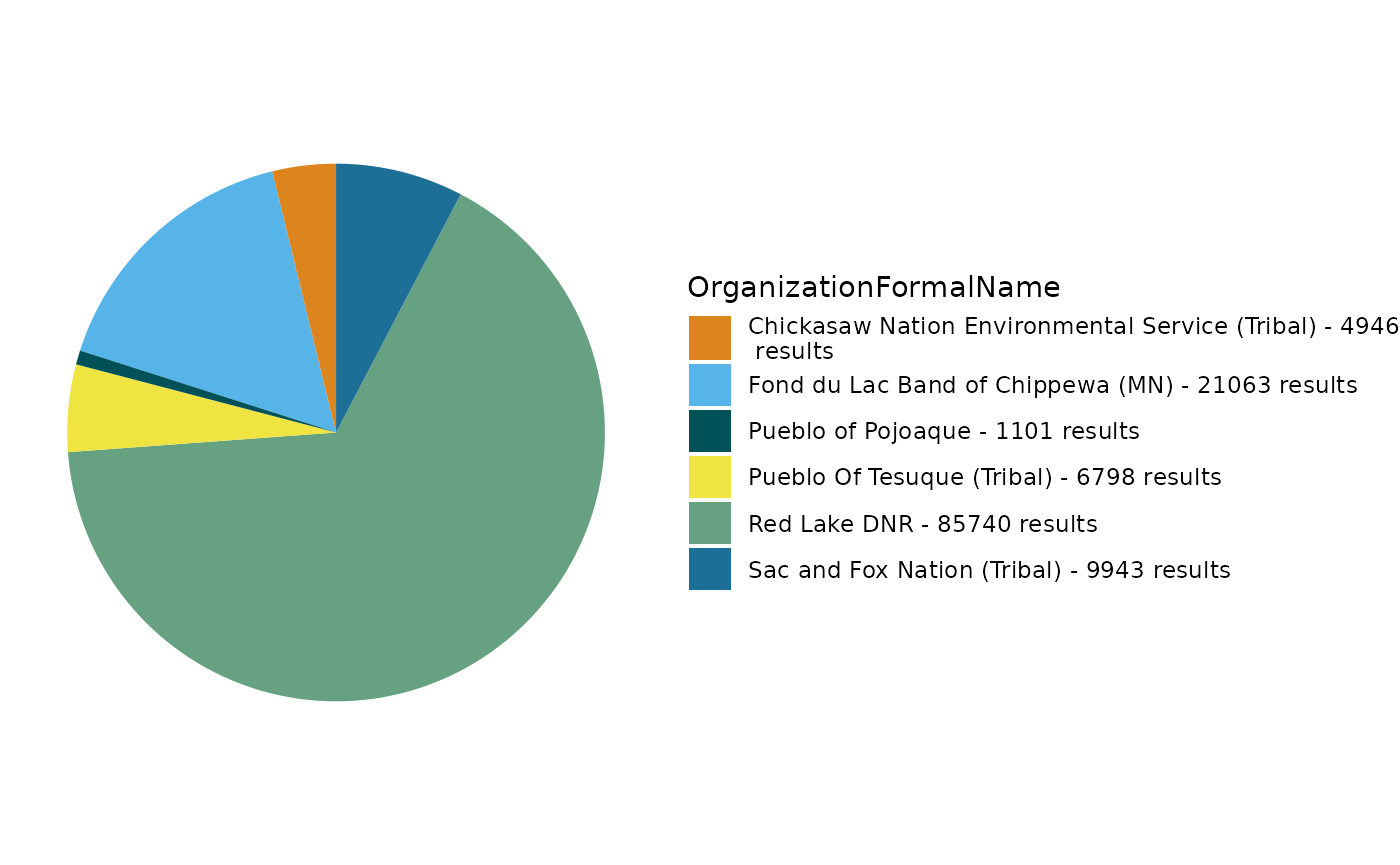
org_counts <- TADA_FieldValuesTable(dataset, field = "OrganizationFormalName")
org_counts## Value Count
## 1 Red Lake DNR 85740
## 2 Fond du Lac Band of Chippewa (MN) 22945
## 3 Sac and Fox Nation (Tribal) 9943
## 4 Pueblo Of Tesuque (Tribal) 6798
## 5 Chickasaw Nation Environmental Service (Tribal) 4946
## 6 Pueblo of Pojoaque 1101Question 4: When might a user choose to view a column’s unique values as a table rather than in a pie chart?
We can take a quick look at some of the TADA-created columns that
review result value types. Because TADA is intended to work with numeric
data, at this point, it would be good to remove those result values that
are NA without any detection limit info, or contain text or special
characters that cannot be converted to numeric. Note that TADA will fill
in missing values with detection limit values and units with the
TADA_IDCensoredData if the ResultDetectionConditionText and
DetectionQuantitationLimitType fields are populated. See
?TADA_ConvertSpecialChars for more details on result value
types and handling and ?TADA_IDCensoredData for details on
censored data preparation.
First, we can run TADA_IDCensoredData to fill in as many
NA/missing values as possible. We can use
TADA_FieldValuesPie to view the censored data flags
identified in the dataframe and their relative frequency.
TADA_IDCensoredData sorts result values into detection
limit categories (e.g. non-detect, over-detect) based on populated
values in the ResultDetectionConditionText and
DetectionQuantitationLimitTypeName columns.
You can find the reference tables used to make these decisions in
TADA_GetDetCondRef() and TADA_GetDetLimitRef()
functions. In some cases, results are missing detection limit/condition
info, or there is a conflict in the detection limit and condition. The
user may want to remove problematic detection limit data before
proceeding. We can also filter for the “problem” data by
TADA.CensoredData.Flag and review the unique reasons for data
removal.
dataset <- TADA_IDCensoredData(dataset)## [1] "TADA_IDCensoredData: There are 115 results in your dataframe that are missing ResultDetectionConditionText. TADA requires BOTH ResultDetectionConditionText and DetectionQuantitationLimitTypeName fields to be populated in order to categorize censored data."
## [1] "TADA_IDCensoredData: DetectionQuantitationLimitTypeName column in dataframe contains value(s) NA which is/are not represented in the DetectionQuantitationLimitTypeName WQX domain table. These data records are placed under the TADA.CensoredData.Flag: Censored but not Categorized, and will not be used in censored data handling methods. Please contact TADA administrators to resolve."
TADA_FieldValuesPie(dataset, field = "TADA.CensoredData.Flag")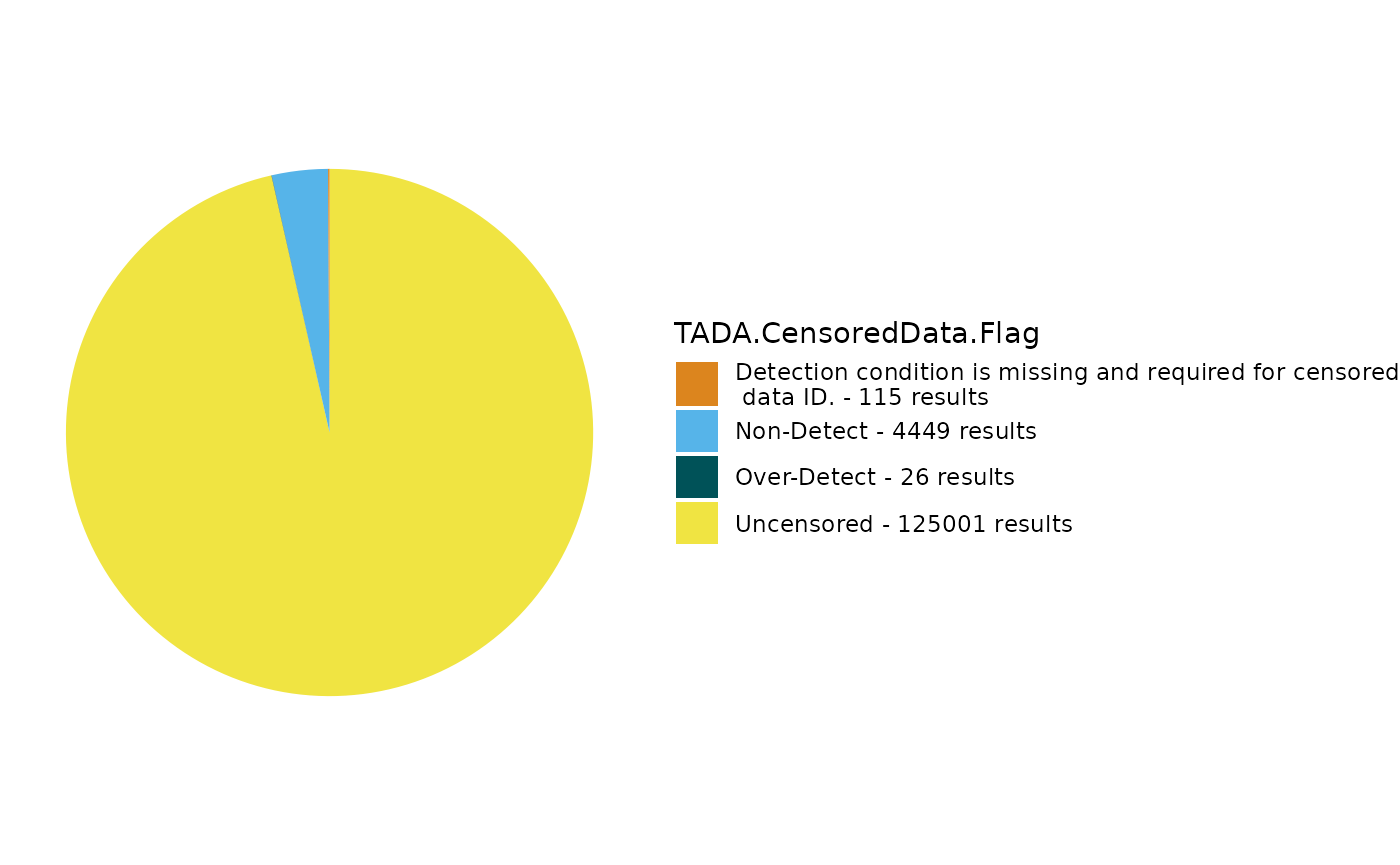
problem_censored <- dataset |>
dplyr::filter(!TADA.CensoredData.Flag %in% c("Non-Detect", "Over-Detect", "Other", "Uncensored")) |>
dplyr::mutate(TADA.RemovalReason = "Detection limit information contains errors or missing information.")
# Let's take a look at the problematic data that we filtered out (if any)
check <- unique(problem_censored[, c("TADA.CharacteristicName", "ResultDetectionConditionText", "DetectionQuantitationLimitTypeName", "TADA.CensoredData.Flag")])
check## TADA.CharacteristicName ResultDetectionConditionText
## 1 PHEOPHYTIN A <NA>
## 10 CHLOROPHYLL A <NA>
## 12 ORTHOPHOSPHATE <NA>
## 14 NITRATE <NA>
## 15 NITRITE <NA>
## 23 ALKALINITY, TOTAL <NA>
## 27 CHROMIUM <NA>
## 28 COPPER <NA>
## 104 SULFATE <NA>
## DetectionQuantitationLimitTypeName
## 1 <NA>
## 10 <NA>
## 12 Method Detection Level
## 14 Method Detection Level
## 15 Method Detection Level
## 23 Method Detection Level
## 27 Method Detection Level
## 28 Method Detection Level
## 104 Method Detection Level
## TADA.CensoredData.Flag
## 1 Detection condition is missing and required for censored data ID.
## 10 Detection condition is missing and required for censored data ID.
## 12 Detection condition is missing and required for censored data ID.
## 14 Detection condition is missing and required for censored data ID.
## 15 Detection condition is missing and required for censored data ID.
## 23 Detection condition is missing and required for censored data ID.
## 27 Detection condition is missing and required for censored data ID.
## 28 Detection condition is missing and required for censored data ID.
## 104 Detection condition is missing and required for censored data ID.
dataset <- dataset |> dplyr::filter(TADA.CensoredData.Flag %in% c("Non-Detect", "Over-Detect", "Other", "Uncensored"))
# Let's take a look at the removed data
removed <- plyr::rbind.fill(removed, problem_censored)
# dimension check
dimCheck(all_result_num, dataset, removed, checkName = "Censored Data")## [1] "Good to go. Zero results created or destroyed in Censored Data check."Next, we can take a look at the data types present and filter out any non-allowable types.
# take a look at datatypes
flag.datatypes <- TADA_FieldValuesTable(dataset, field = "TADA.ResultMeasureValueDataTypes.Flag")
# Numeric or numeric-coerced data types
rv_datatypes <- unique(subset(dataset, !is.na(dataset$TADA.ResultMeasureValue))$TADA.ResultMeasureValueDataTypes.Flag)
# Non-numeric data types coerced to NA
na_rv_datatypes <- unique(subset(dataset, is.na(dataset$TADA.ResultMeasureValue))$TADA.ResultMeasureValueDataTypes.Flag)
# these are all of the NOT allowable data types in the dataset.
incompatible_datatype <- dataset |>
dplyr::filter(!dataset$TADA.ResultMeasureValueDataTypes.Flag %in% c("Numeric", "Less Than", "Greater Than", "Approximate Value", "Percentage", "Comma-Separated Numeric", "Numeric Range - Averaged", "Result Value/Unit Copied from Detection Limit")) |>
dplyr::mutate(TADA.RemovalReason = "Result value type cannot be converted to numeric or no detection limit values provided.")
# take a look at the difficult data types - do they make sense?
check <- unique(incompatible_datatype[, c("TADA.CharacteristicName", "ResultMeasureValue", "TADA.ResultMeasureValue", "ResultMeasure.MeasureUnitCode", "TADA.ResultMeasure.MeasureUnitCode", "TADA.ResultMeasureValueDataTypes.Flag", "DetectionQuantitationLimitMeasure.MeasureValue", "TADA.DetectionQuantitationLimitMeasure.MeasureValue", "DetectionQuantitationLimitMeasure.MeasureUnitCode", "TADA.DetectionQuantitationLimitMeasure.MeasureUnitCode")])
check## TADA.CharacteristicName
## 1 LOONS, VISUAL OBSERVATION
## 3 CLOUD COVER
## 6 WIND VELOCITY
## 7 CLOUD COVER
## 17 CLOUD COVER
## 23 HEIGHT, GAGE
## 32 TRUE COLOR
## 33 TOTAL HARDNESS
## 34 APPARENT COLOR
## 35 ALKALINITY
## 36 WATER APPEARANCE (TEXT)
## 37 WATER APPEARANCE (TEXT)
## 39 WATER APPEARANCE (TEXT)
## 41 WATER APPEARANCE (TEXT)
## 42 WATER APPEARANCE (TEXT)
## 44 WATER APPEARANCE (TEXT)
## 50 WATER APPEARANCE (TEXT)
## 66 WATER APPEARANCE (TEXT)
## 70 WATER APPEARANCE (TEXT)
## 87 WATER APPEARANCE (TEXT)
## 92 WATER APPEARANCE (TEXT)
## 95 WATER APPEARANCE (TEXT)
## 132 WATER APPEARANCE (TEXT)
## 164 WATER APPEARANCE (TEXT)
## 166 WATER APPEARANCE (TEXT)
## 216 WATER APPEARANCE (TEXT)
## 234 WATER APPEARANCE (TEXT)
## 280 WATER APPEARANCE (TEXT)
## 294 WATER APPEARANCE (TEXT)
## 369 WATER APPEARANCE (TEXT)
## 426 WATER APPEARANCE (TEXT)
## 492 WATER APPEARANCE (TEXT)
## 502 WATER APPEARANCE (TEXT)
## 508 WATER APPEARANCE (TEXT)
## 578 WATER APPEARANCE (TEXT)
## 598 WATER APPEARANCE (TEXT)
## 600 WATER APPEARANCE (TEXT)
## 672 WATER APPEARANCE (TEXT)
## 804 WATER APPEARANCE (TEXT)
## 817 WATER APPEARANCE (TEXT)
## 964 WATER APPEARANCE (TEXT)
## 1103 FLOW
## 1104 BAROMETRIC PRESSURE
## 1105 BAROMETRIC PRESSURE
## 1113 WATER APPEARANCE (TEXT)
## 1313 WATER APPEARANCE (TEXT)
## 1503 WATER APPEARANCE (TEXT)
## 1615 TEMPERATURE, WATER
## 1616 DISSOLVED OXYGEN SATURATION
## 1617 CONDUCTIVITY
## 1618 TOTAL DISSOLVED SOLIDS
## 1643 WATER APPEARANCE (TEXT)
## 1919 WATER APPEARANCE (TEXT)
## 2027 WATER APPEARANCE (TEXT)
## 2046 WATER APPEARANCE (TEXT)
## 2248 WATER APPEARANCE (TEXT)
## 2333 LAKE RECREATIONAL SUITABILITY (CHOICE LIST)
## 2373 LAKE RECREATIONAL SUITABILITY (CHOICE LIST)
## 2381 LAKE RECREATIONAL SUITABILITY (CHOICE LIST)
## 2427 WATER APPEARANCE (TEXT)
## ResultMeasureValue
## 1 <NA>
## 3 foggy
## 6 Calm
## 7 clear_sunny
## 17 raining
## 23 1:78
## 32 <NA>
## 33 <NA>
## 34 <NA>
## 35 <NA>
## 36 Sediment; some algae present
## 37 Stain; some algae present
## 39 Sediment
## 41 Stain; Some algae present
## 42 Clear; Crystal Clear
## 44 Stain
## 50 Green; some algae present
## 66 Green; Some algae present
## 70 Stained; Crystal Clear
## 87 Green; crystal clear
## 92 Sediment; Some algae present
## 95 Clear water color; crystal clear physical conditions
## 132 Clear; some algae present
## 164 Stain; crystal clear
## 166 Green; definite algae present
## 216 Clear
## 234 Green
## 280 Tea-colored
## 294 Clear; Some algae present
## 369 Stain; Crystal clear
## 426 Cloudy
## 492 Water color clear; physical condition crystal clear
## 502 Water color stained; physical condition crystal clear
## 508 Stain; Definite algae present
## 578 Green; Crystal Clear
## 598 Sediment; Crystal clear
## 600 Sediment; Crystal Clear
## 672 Green; Definite algae present
## 804 Sediment; Definitie algae present
## 817 Green; Crystal clear
## 964 Stained
## 1103 <NA>
## 1104 600.7061 mmHG
## 1105 600.71 mmHG
## 1113 Clear; Crystal clear
## 1313 Sediment; Definite algae present
## 1503 Stain; definite algae present
## 1615 None
## 1616 mg/l
## 1617 mg/l
## 1618 PSS
## 1643 Clear; crystal clear
## 1919 Clear; Definite algae present
## 2027 Sediment; Stage tape-down from bridge
## 2046 Sediment; definite algae present
## 2248 Muddy
## 2333 1.VERY GOOD
## 2373 2.GOOD
## 2381 3.FAIR
## 2427 Green; High algal color
## TADA.ResultMeasureValue ResultMeasure.MeasureUnitCode
## 1 NA <NA>
## 3 NA %
## 6 NA mph
## 7 NA %
## 17 NA %
## 23 NA ft
## 32 NA CU
## 33 NA mg/L
## 34 NA CU
## 35 NA mg/L
## 36 NA <NA>
## 37 NA <NA>
## 39 NA <NA>
## 41 NA <NA>
## 42 NA <NA>
## 44 NA <NA>
## 50 NA <NA>
## 66 NA <NA>
## 70 NA <NA>
## 87 NA <NA>
## 92 NA <NA>
## 95 NA <NA>
## 132 NA <NA>
## 164 NA <NA>
## 166 NA <NA>
## 216 NA <NA>
## 234 NA <NA>
## 280 NA <NA>
## 294 NA <NA>
## 369 NA <NA>
## 426 NA <NA>
## 492 NA <NA>
## 502 NA <NA>
## 508 NA <NA>
## 578 NA <NA>
## 598 NA <NA>
## 600 NA <NA>
## 672 NA <NA>
## 804 NA <NA>
## 817 NA <NA>
## 964 NA <NA>
## 1103 NA cfs
## 1104 NA psi
## 1105 NA psi
## 1113 NA <NA>
## 1313 NA <NA>
## 1503 NA <NA>
## 1615 NA deg C
## 1616 NA %
## 1617 NA uS/cm
## 1618 NA mg/L
## 1643 NA <NA>
## 1919 NA <NA>
## 2027 NA <NA>
## 2046 NA <NA>
## 2248 NA <NA>
## 2333 NA <NA>
## 2373 NA <NA>
## 2381 NA <NA>
## 2427 NA <NA>
## TADA.ResultMeasure.MeasureUnitCode TADA.ResultMeasureValueDataTypes.Flag
## 1 <NA> NA - Not Available
## 3 % Text
## 6 M/SEC Text
## 7 % Text
## 17 % Text
## 23 M Coerced to NA
## 32 PCU NA - Not Available
## 33 MG/L NA - Not Available
## 34 PCU NA - Not Available
## 35 UG/L NA - Not Available
## 36 <NA> Text
## 37 <NA> Text
## 39 <NA> Text
## 41 <NA> Text
## 42 <NA> Text
## 44 <NA> Text
## 50 <NA> Text
## 66 <NA> Text
## 70 <NA> Text
## 87 <NA> Text
## 92 <NA> Text
## 95 <NA> Text
## 132 <NA> Text
## 164 <NA> Text
## 166 <NA> Text
## 216 <NA> Text
## 234 <NA> Text
## 280 <NA> Text
## 294 <NA> Text
## 369 <NA> Text
## 426 <NA> Text
## 492 <NA> Text
## 502 <NA> Text
## 508 <NA> Text
## 578 <NA> Text
## 598 <NA> Text
## 600 <NA> Text
## 672 <NA> Text
## 804 <NA> Text
## 817 <NA> Text
## 964 <NA> Text
## 1103 CFS NA - Not Available
## 1104 G/M2 Text
## 1105 G/M2 Text
## 1113 <NA> Text
## 1313 <NA> Text
## 1503 <NA> Text
## 1615 DEG C Text
## 1616 % Text
## 1617 US/CM Text
## 1618 UG/L Text
## 1643 <NA> Text
## 1919 <NA> Text
## 2027 <NA> Text
## 2046 <NA> Text
## 2248 <NA> Text
## 2333 <NA> Text
## 2373 <NA> Text
## 2381 <NA> Text
## 2427 <NA> Text
## DetectionQuantitationLimitMeasure.MeasureValue
## 1 <NA>
## 3 <NA>
## 6 <NA>
## 7 <NA>
## 17 <NA>
## 23 <NA>
## 32 <NA>
## 33 <NA>
## 34 <NA>
## 35 <NA>
## 36 <NA>
## 37 <NA>
## 39 <NA>
## 41 <NA>
## 42 <NA>
## 44 <NA>
## 50 <NA>
## 66 <NA>
## 70 <NA>
## 87 <NA>
## 92 <NA>
## 95 <NA>
## 132 <NA>
## 164 <NA>
## 166 <NA>
## 216 <NA>
## 234 <NA>
## 280 <NA>
## 294 <NA>
## 369 <NA>
## 426 <NA>
## 492 <NA>
## 502 <NA>
## 508 <NA>
## 578 <NA>
## 598 <NA>
## 600 <NA>
## 672 <NA>
## 804 <NA>
## 817 <NA>
## 964 <NA>
## 1103 <NA>
## 1104 <NA>
## 1105 <NA>
## 1113 <NA>
## 1313 <NA>
## 1503 <NA>
## 1615 <NA>
## 1616 <NA>
## 1617 <NA>
## 1618 <NA>
## 1643 <NA>
## 1919 <NA>
## 2027 <NA>
## 2046 <NA>
## 2248 <NA>
## 2333 <NA>
## 2373 <NA>
## 2381 <NA>
## 2427 <NA>
## TADA.DetectionQuantitationLimitMeasure.MeasureValue
## 1 NA
## 3 NA
## 6 NA
## 7 NA
## 17 NA
## 23 NA
## 32 NA
## 33 NA
## 34 NA
## 35 NA
## 36 NA
## 37 NA
## 39 NA
## 41 NA
## 42 NA
## 44 NA
## 50 NA
## 66 NA
## 70 NA
## 87 NA
## 92 NA
## 95 NA
## 132 NA
## 164 NA
## 166 NA
## 216 NA
## 234 NA
## 280 NA
## 294 NA
## 369 NA
## 426 NA
## 492 NA
## 502 NA
## 508 NA
## 578 NA
## 598 NA
## 600 NA
## 672 NA
## 804 NA
## 817 NA
## 964 NA
## 1103 NA
## 1104 NA
## 1105 NA
## 1113 NA
## 1313 NA
## 1503 NA
## 1615 NA
## 1616 NA
## 1617 NA
## 1618 NA
## 1643 NA
## 1919 NA
## 2027 NA
## 2046 NA
## 2248 NA
## 2333 NA
## 2373 NA
## 2381 NA
## 2427 NA
## DetectionQuantitationLimitMeasure.MeasureUnitCode
## 1 <NA>
## 3 <NA>
## 6 <NA>
## 7 <NA>
## 17 <NA>
## 23 <NA>
## 32 <NA>
## 33 <NA>
## 34 <NA>
## 35 <NA>
## 36 <NA>
## 37 <NA>
## 39 <NA>
## 41 <NA>
## 42 <NA>
## 44 <NA>
## 50 <NA>
## 66 <NA>
## 70 <NA>
## 87 <NA>
## 92 <NA>
## 95 <NA>
## 132 <NA>
## 164 <NA>
## 166 <NA>
## 216 <NA>
## 234 <NA>
## 280 <NA>
## 294 <NA>
## 369 <NA>
## 426 <NA>
## 492 <NA>
## 502 <NA>
## 508 <NA>
## 578 <NA>
## 598 <NA>
## 600 <NA>
## 672 <NA>
## 804 <NA>
## 817 <NA>
## 964 <NA>
## 1103 <NA>
## 1104 <NA>
## 1105 <NA>
## 1113 <NA>
## 1313 <NA>
## 1503 <NA>
## 1615 <NA>
## 1616 <NA>
## 1617 <NA>
## 1618 <NA>
## 1643 <NA>
## 1919 <NA>
## 2027 <NA>
## 2046 <NA>
## 2248 <NA>
## 2333 <NA>
## 2373 <NA>
## 2381 <NA>
## 2427 <NA>
## TADA.DetectionQuantitationLimitMeasure.MeasureUnitCode
## 1 <NA>
## 3 <NA>
## 6 <NA>
## 7 <NA>
## 17 <NA>
## 23 <NA>
## 32 <NA>
## 33 <NA>
## 34 <NA>
## 35 <NA>
## 36 <NA>
## 37 <NA>
## 39 <NA>
## 41 <NA>
## 42 <NA>
## 44 <NA>
## 50 <NA>
## 66 <NA>
## 70 <NA>
## 87 <NA>
## 92 <NA>
## 95 <NA>
## 132 <NA>
## 164 <NA>
## 166 <NA>
## 216 <NA>
## 234 <NA>
## 280 <NA>
## 294 <NA>
## 369 <NA>
## 426 <NA>
## 492 <NA>
## 502 <NA>
## 508 <NA>
## 578 <NA>
## 598 <NA>
## 600 <NA>
## 672 <NA>
## 804 <NA>
## 817 <NA>
## 964 <NA>
## 1103 <NA>
## 1104 <NA>
## 1105 <NA>
## 1113 <NA>
## 1313 <NA>
## 1503 <NA>
## 1615 <NA>
## 1616 <NA>
## 1617 <NA>
## 1618 <NA>
## 1643 <NA>
## 1919 <NA>
## 2027 <NA>
## 2046 <NA>
## 2248 <NA>
## 2333 <NA>
## 2373 <NA>
## 2381 <NA>
## 2427 <NA>Then we can take a closer look at the removed results and run another dimension check on the data set.
# filter data set to include allowable data types
dataset <- dataset |> dplyr::filter(dataset$TADA.ResultMeasureValueDataTypes.Flag %in% c("Numeric", "Less Than", "Greater Than", "Approximate Value", "Percentage", "Comma-Separated Numeric", "Numeric Range - Averaged", "Result Value/Unit Copied from Detection Limit"))
# create dataframe to includ all removed results
removed <- plyr::rbind.fill(removed, incompatible_datatype)
# dimension check
dimCheck(all_result_num, dataset, removed, checkName = "Result Format")## [1] "Good to go. Zero results created or destroyed in Result Format check."Data flagging
We’ve taken a quick look at the raw dataframe and split off some data
that are not compatible with TADA, now let’s run through some quality
control checks. The most important ones to run to ensure your dataframe
is ready for subsequent steps are TADA_FlagFraction(),
TADA_FlagSpeciation(), TADA_FlagResultUnit(),
and TADA_FindQCActivities(). With the exception of
TADA_FindQCActivities(), these flagging functions leverage
WQX’s QAQC
Validation Table. See the WQX
QAQC Service User Guide for more details on how TADA leverages the
validation table to flag potentially suspect data.
TADA_FindQCActivities() uses a TADA-specific domain table
users can review with TADA_GetActivityTypeRef(). All QAQC
tables are frequently updated in the package to ensure they match the
latest version on the web.
Bring the QAQC Validation Table into your R session to view or save with the following command:
qaqc_ref <- TADA_GetWQXCharValRef()
unique(qaqc_ref$Type)## [1] "CharacteristicFraction" "CharacteristicMethod"
## [3] "CharacteristicSpeciation" "CharacteristicUnit"Question 5: What do you think the qaqc_ref$Type
column indicates?
TADA joins this validation table to the data and uses the “Pass” and “Suspect” labels in the TADA.WQXVal.Flag column to create easily understandable flagging columns for each function. Let’s run these four flagging functions.
dataset_flags <- TADA_FlagFraction(dataset, clean = FALSE, flaggedonly = FALSE)## [1] "TADA_FlagFraction: Rows with Suspect sample fractions have been flagged but retained. Review these rows using the TADA.SampleFraction.Flag column before proceeding and/or set clean = TRUE."
dataset_flags <- TADA_FlagSpeciation(dataset_flags, clean = "none", flaggedonly = FALSE)## [1] "TADA_FlagSpeciation: Rows with Suspect speciations have been flagged but retained. Review these rows using the new TADA.MethodSpeciation.Flag column before proceeding and/or set clean = 'suspect_only' or 'both'."
dataset_flags <- TADA_FlagResultUnit(dataset_flags, clean = "none", flaggedonly = FALSE)
dataset_flags <- TADA_FindQCActivities(dataset_flags, clean = FALSE, flaggedonly = FALSE)
dimCheck(all_result_num, dataset_flags, removed, checkName = "Run Flag Functions")## [1] "Good to go. Zero results created or destroyed in Run Flag Functions check."Question 6: Did any warnings or messages appear in the console after running these flagging functions? What do they say?
Now that we’ve run all the key flagging functions, let’s take a look at the results and make some decisions.
TADA_FieldValuesPie(dataset_flags, field = "TADA.SampleFraction.Flag")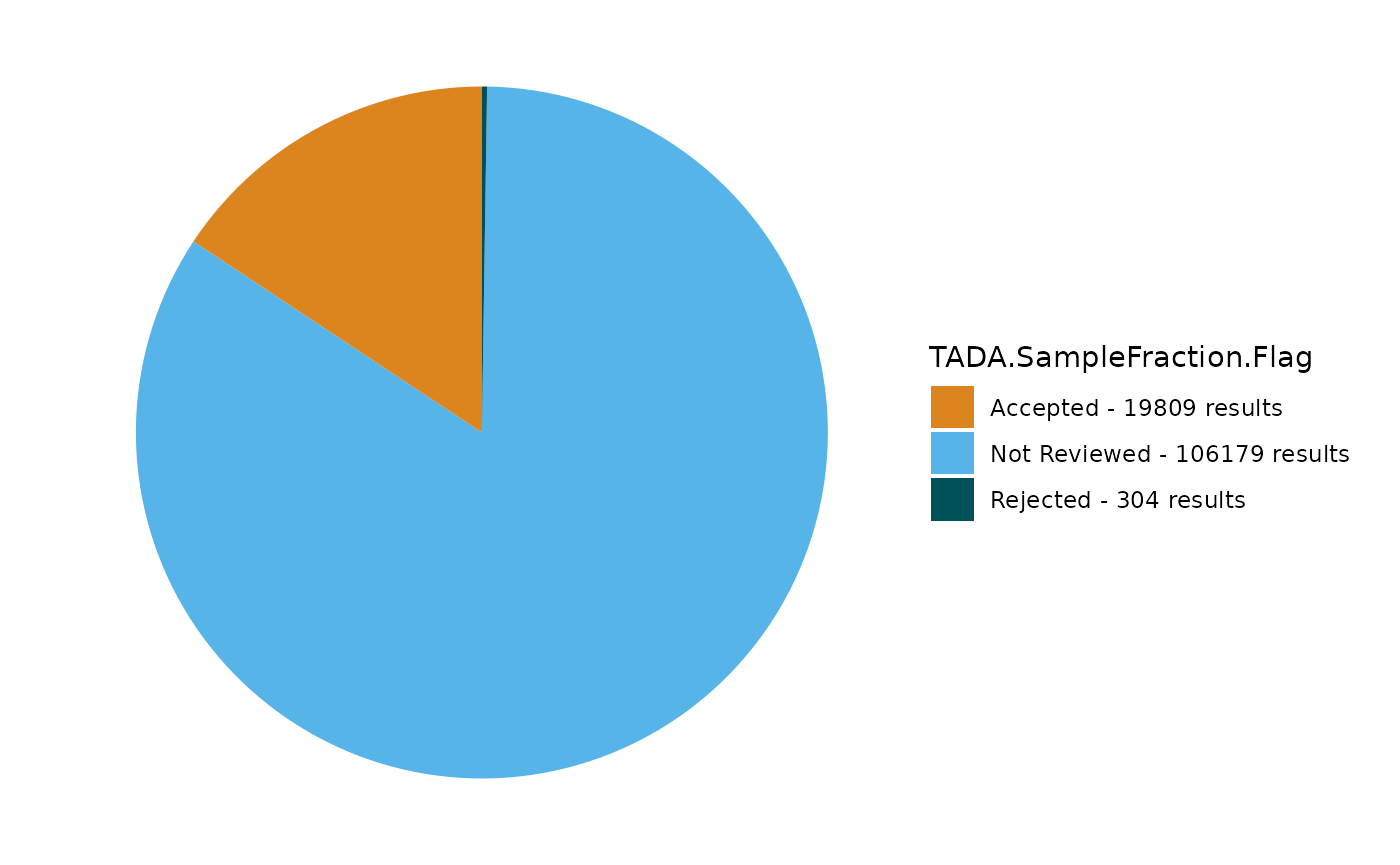
TADA_FieldValuesPie(dataset_flags, field = "TADA.MethodSpeciation.Flag")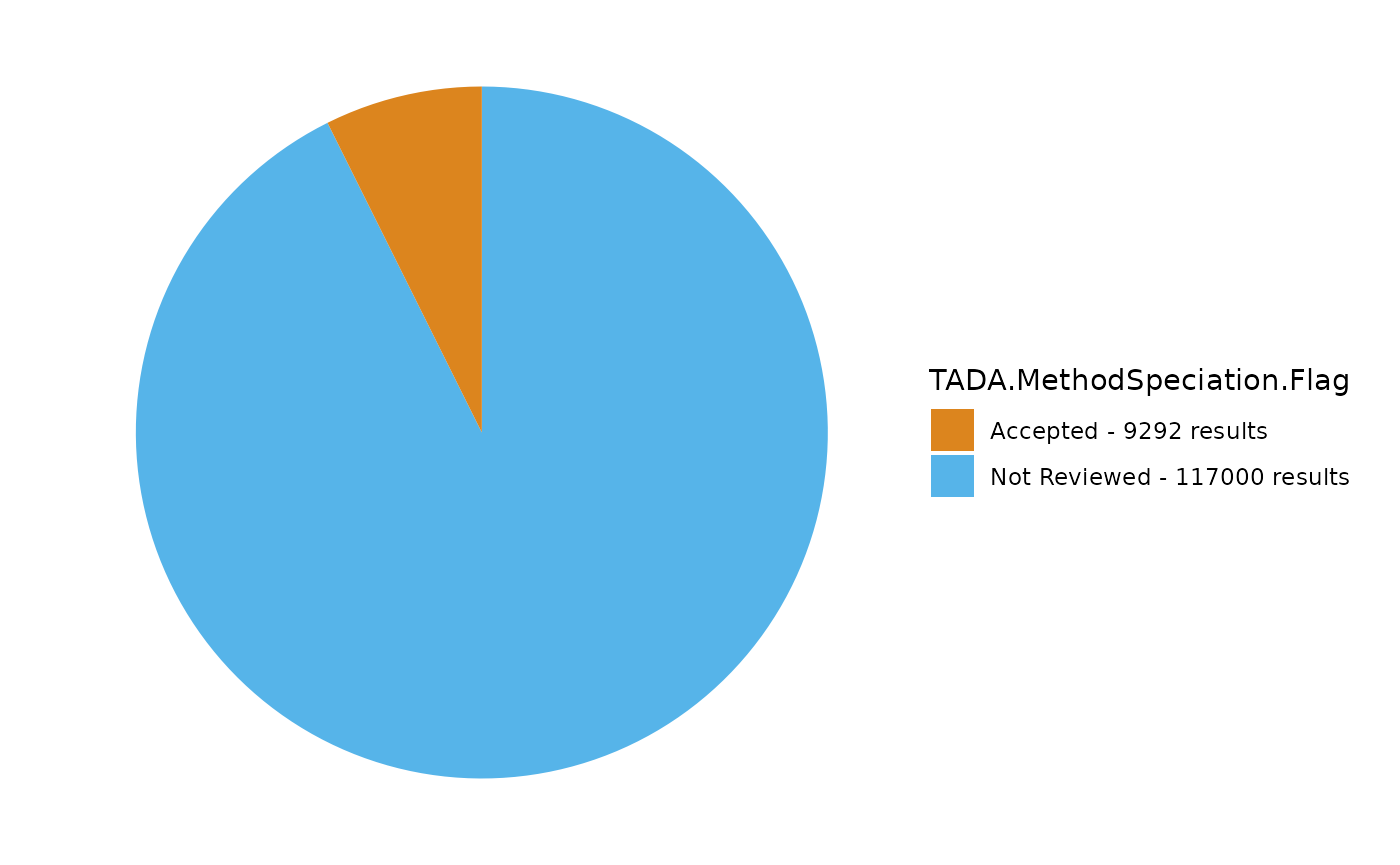
TADA_FieldValuesPie(dataset_flags, field = "TADA.ResultUnit.Flag")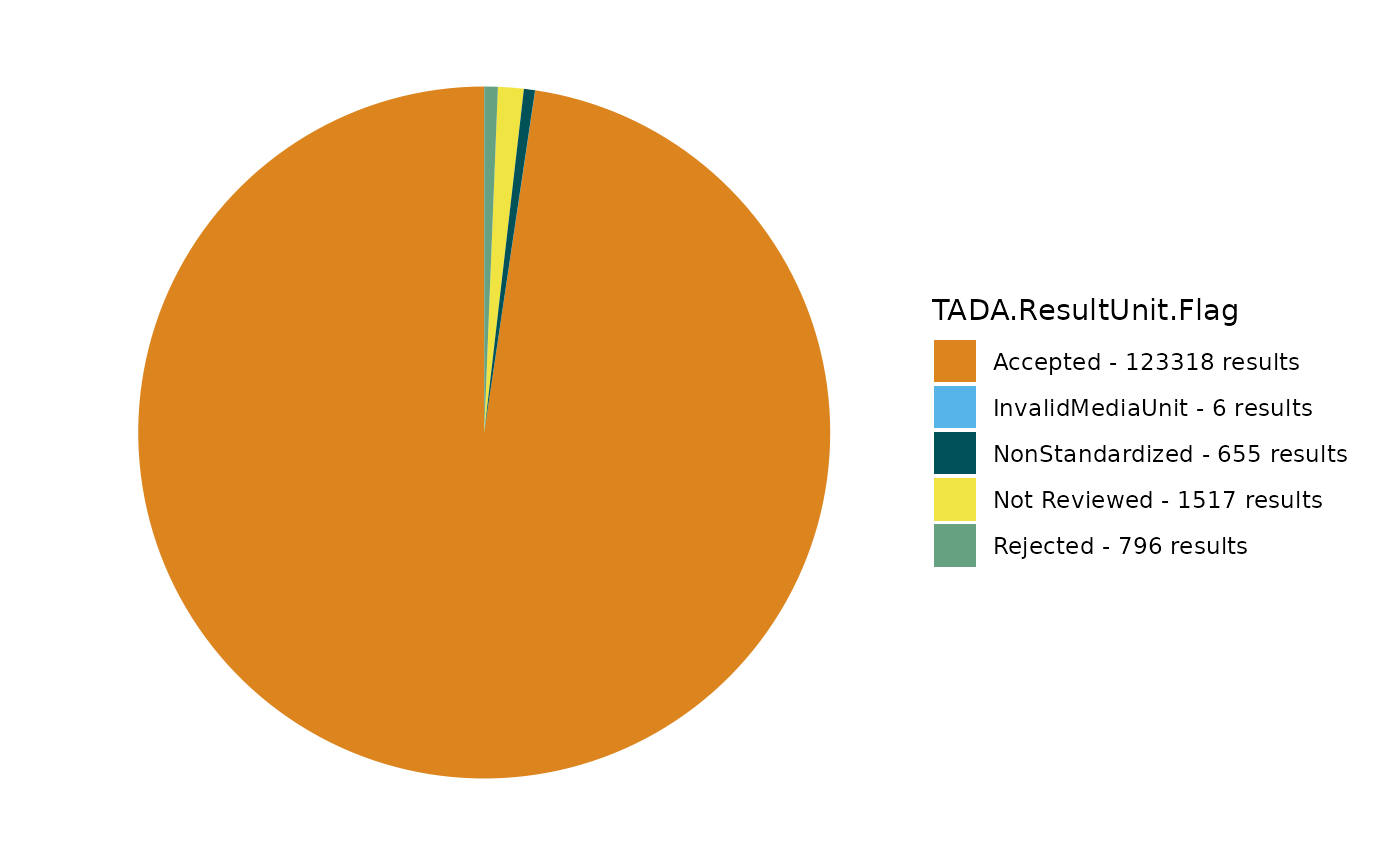
TADA_FieldValuesPie(dataset_flags, field = "TADA.ActivityType.Flag")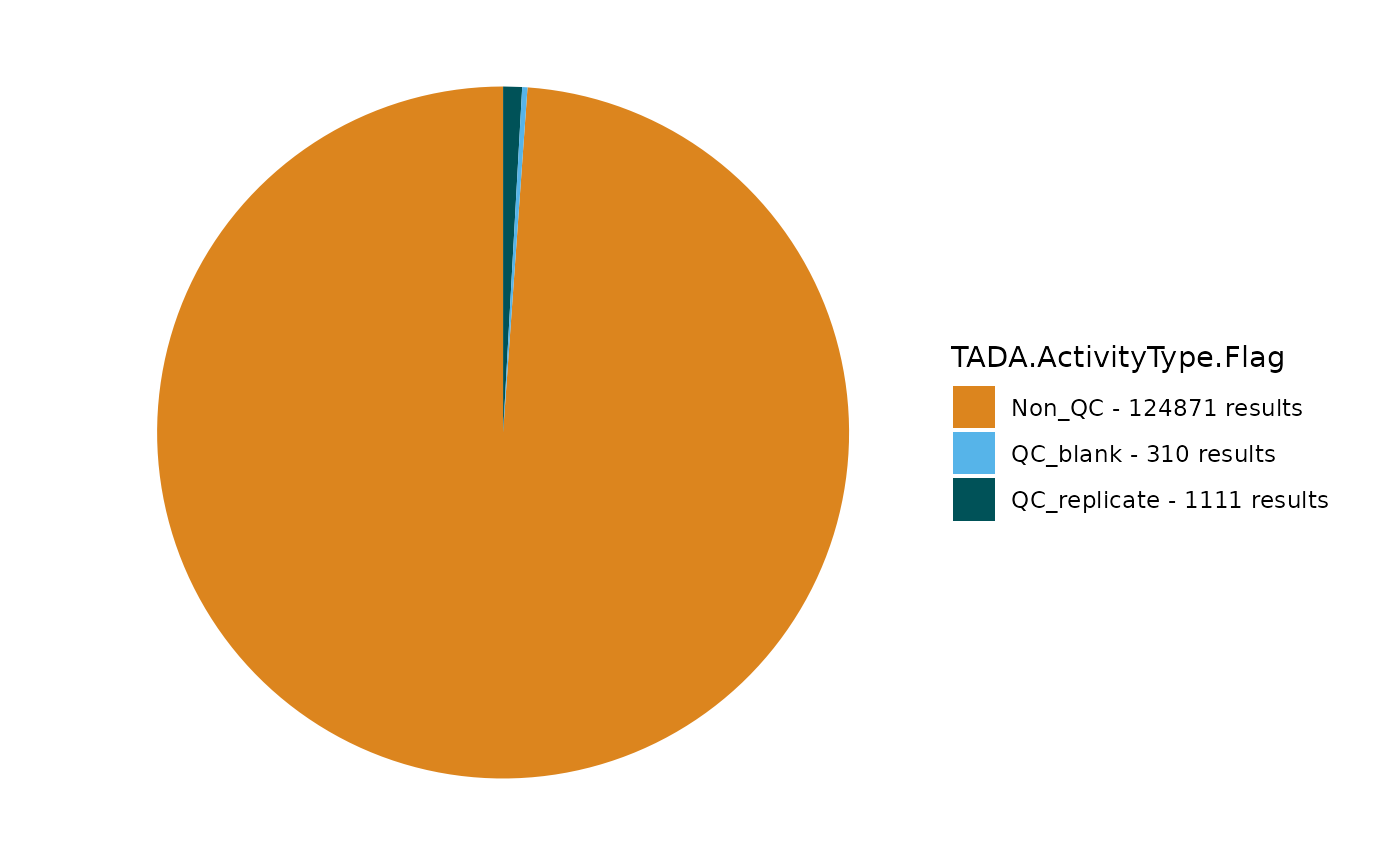
Any results flagged as “Suspect” are recognized in the QAQC Validation Table as having some data quality issue. “NonStandardized” means that the format has not been fully vetted or processed, while “Pass” confirms that the characteristic combination is widely recognized as correctly formatted. Let’s add any suspect results to the removed dataframe for later review.
Note: if you find any errors in the QAQC Validation Table, please contact the WQX Help Desk at WQX@epa.gov to help correct it. Thanks in advance!
# grab all the flagged results from the four functions
problem_flagged <- dataset_flags |>
dplyr::filter(TADA.SampleFraction.Flag == "Suspect" | TADA.MethodSpeciation.Flag == "Suspect" | TADA.ResultUnit.Flag == "Suspect" | !TADA.ActivityType.Flag %in% ("Non_QC")) |>
dplyr::mutate(TADA.RemovalReason = "Invalid Unit, Method, Speciation, or Activity Type.")
dataset_flags <- dataset_flags |> dplyr::filter(!ResultIdentifier %in% problem_flagged$ResultIdentifier)
# create dataframe of removed results
removed <- plyr::rbind.fill(removed, problem_flagged)
# remove df no longer needed
rm(problem_flagged)
# dimension check
dimCheck(all_result_num, dataset_flags, removed, checkName = "Filter Flag Functions")## [1] "Good to go. Zero results created or destroyed in Filter Flag Functions check."Question 7: Are there any other metadata columns that you review and filter in your workflow?
We’ve finished running the recommended flagging functions and removing results that do not pass QC checks. Let’s look at the breakdown of these data in the removed object.
removal <- TADA_FieldValuesTable(removed, field = "TADA.RemovalReason")
removal## Value
## 1 Activity media is not water.
## 2 Result value type cannot be converted to numeric or no detection limit values provided.
## 3 Invalid Unit, Method, Speciation, or Activity Type.
## 4 Detection limit information contains errors or missing information.
## Count
## 1 4459
## 2 3184
## 3 2518
## 4 115You can review any other columns of interest and create custom domain tables of your “Valid” and “Invalid” criteria using R or Excel. Also check out some of the other flagging functions available in TADA:
?TADA_FindNearbySites()?TADA_FindPotentialDuplicatesMultipleOrgs()?TADA_FindPotentialDuplicatesSingleOrg()?TADA_FindQAPPApproval()?TADA_FindQAPPDoc()?TADA_FlagAboveThreshold()?TADA_FlagBelowThreshold()?TADA_FlagContinuousData()?TADA_FlagCoordinates()?TADA_FlagMeasureQualifierCode()?TADA_FlagMethod()
Please let us know of other flagging functions you think would have broad appeal in the TADA package or need assistance brainstorming/developing.
Censored data handling
We have already identified, flagged, and in some cases removed problematic detection limit data from our dataframe, but that doesn’t keep them from being difficult. Because we do not know the result value with adequate precision, water quality data users often set non-detect values to some number below the reported detection limit. TADA contains some simple methods for handling detection limits: users may multiply the detection limit by some number between 0 and 1, or convert the detection limit value to a random number between 0 and the detection limit. More complex detection limit estimation requiring regression models (Maximum Likelihood, Kaplan-Meier, Robust Regression on Order Statistics) or similar must be performed outside of the current version of TADA (though future development is planned).
Question 8: How would you parameterize
TADA_SimpleCensoredMethods() to make non-detect values
equal to the provided detection limit? What would you need to change in
the example below?
dataset_cens <- TADA_SimpleCensoredMethods(dataset_flags,
nd_method = "multiplier",
nd_multiplier = 0.5,
od_method = "as-is"
)Let’s take a look at how the censored data handling function affects
the TADA.ResultMeasureValueDataTypes.Flag column.
First, we can look use TADA_FieldValuesTable to look at
the TADA.ResultMeasureValueDataTypes.Flag column in data set before we
ran TADA_SimpleCensoredMethods.
# before
TADA_FieldValuesTable(dataset_flags, field = "TADA.ResultMeasureValueDataTypes.Flag")## Value Count
## 1 Numeric 120823
## 2 Result Value/Unit Copied from Detection Limit 4032
## 3 Percentage 745
## 4 Numeric Range - Averaged 33
## 5 Less Than 19
## 6 Greater Than 3
## 7 Comma-Separated Numeric 1Then we can use TADA_FieldValuesTable again to look at
the same column after TADA_SimpleCensoredMethods.
# after
TADA_FieldValuesTable(dataset_cens, field = "TADA.ResultMeasureValueDataTypes.Flag")## Value Count
## 1 Numeric 120783
## 2 Result Value/Unit Estimated from Detection Limit 4072
## 3 Percentage 745
## 4 Numeric Range - Averaged 33
## 5 Less Than 19
## 6 Greater Than 3
## 7 Comma-Separated Numeric 1Question 9: Is there a difference between the first and second tables?
If you’d like to start thinking about using statistical methods to
estimate detection limit values, check out the ?TADA_Stats
function, which accepts user-defined data groupings (or defaults to
TADA.ComparableDataIdentifier to determine measurement count, location
count, censored data stats, min, max, and percentile stats, and suggests
non-detect estimation methods based on the number of results, % of data
frame censored, and number of censoring levels (detection limits). The
decision tree used in the function was outlined in a National
Nonpoint Source Tech Memo.
Data exploration
How are you feeling about your test dataframe? Does it seem ready for
the next step(s) in your analyses? There’s probably a lot more you’d
like to look at/filter out before you’re ready to say: QC complete.
Let’s first check out characteristics in the dataframe using
dplyr functions and pipes.
# get table of characteristics with number of results, sites, and organizations
dataset_cens_summary <- dataset_cens |>
dplyr::group_by(TADA.CharacteristicName) |>
dplyr::summarise(Result_Count = length(ResultIdentifier), Site_Count = length(unique(TADA.MonitoringLocationIdentifier)), Org_Count = length(unique(OrganizationIdentifier))) |>
dplyr::arrange(desc(Result_Count))You may see a characteristic that you’d like to investigate further
in isolation. TADA_FieldValuesPie() will also produce
summary pie charts for a given column within a specific
characteristic. Let’s take a look.
# go ahead and pick a characteristic name from the table generated above. I picked dissolved oxygen (DO) amd selected OrganizationFormalName as the field to see the relative contribution of each org to DO results
TADA_FieldValuesPie(dataset_cens, field = "OrganizationFormalName", characteristicName = "DISSOLVED OXYGEN (DO)")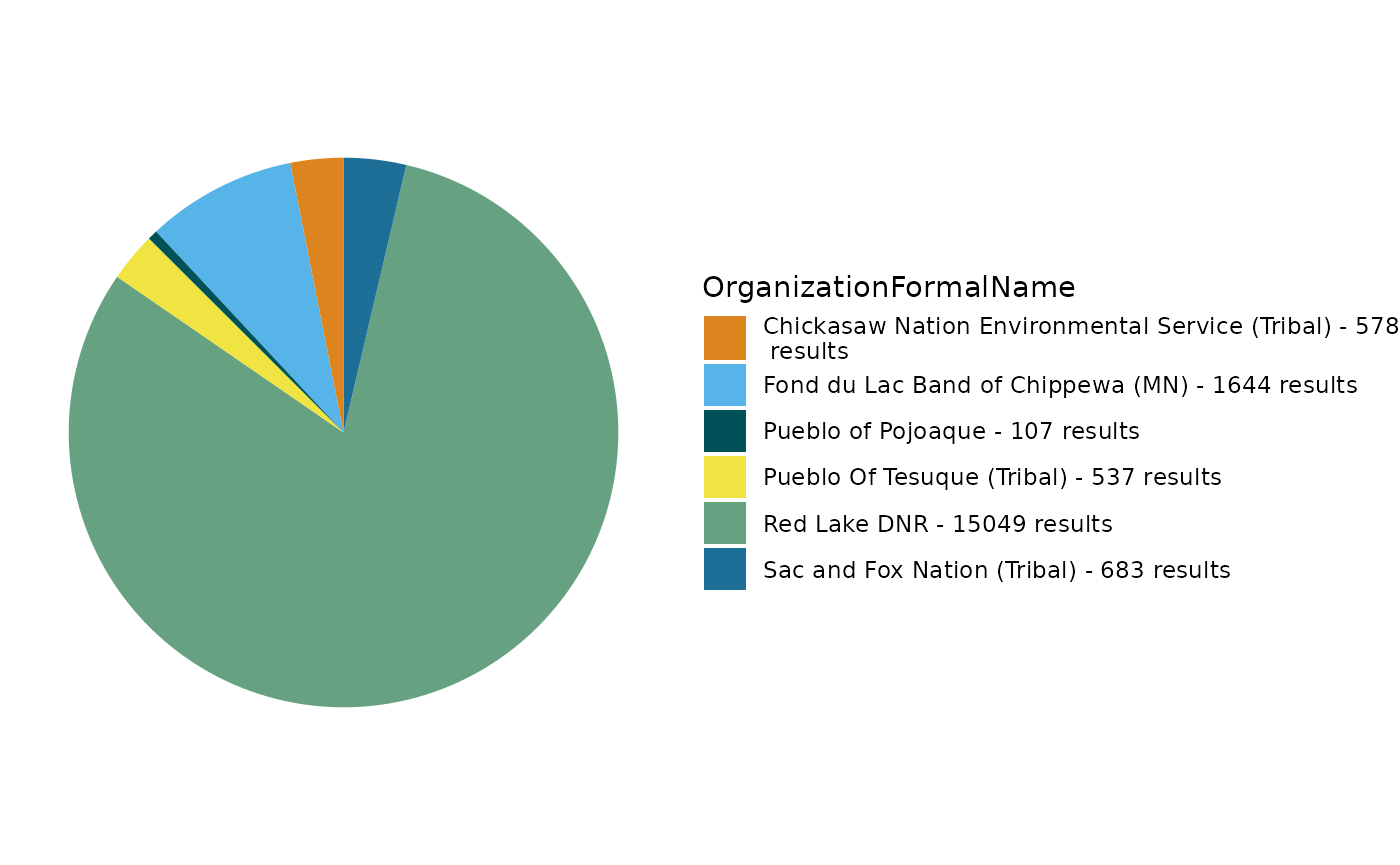
We can view the site locations using a TADA mapping function. In this map, the circles indicate monitoring locations in the data set; their size corresponds to the number of results collected at that site, while the darker the circle, the more characteristics were sampled at that site.
TADA_OverviewMap(dataset_cens)Out of curiosity, let’s take a look at a breakdown of these monitoring location types. Do they all indicate surface water samples? Depending upon your program’s goals and methods, you might want to filter out some of the types you see.
TADA_FieldValuesPie(dataset_cens, field = "TADA.MonitoringLocationTypeName")
One of the next big steps is data harmonization: translating and
aggregating synonyms, combining multiple forms/species of certain
characteristics, etc. We won’t get to that in this demo (more details
can be found here: TADA
Module 1: Water Quality Portal Data Discovery and Cleaning or TADA_HarmonizeSynonyms()),
but for now we can start looking at data distributions within a single
characteristic-speciation-fraction-unit using the plotting functions
TADA_Histogram() and TADA_Boxplot(). We can
also view a stats table using TADA_Stats.
Let’s first take a look at the column TADA.ComparableDataIdentifier, which breaks down characteristics into groups by name, fraction, speciation, and unit. These four columns are important to evaluate together to ensure the plotted data are sufficiently similar to appear on a single plot together: it doesn’t make sense to plot characteristics with different units or fractions in the same distribution.
# trusty field values table - lets just look at the first few entries with the most associated records
compid <- TADA_FieldValuesTable(dataset_cens, field = "TADA.ComparableDataIdentifier")Now that we have an idea for what the TADA.ComparableDataIdentifier looks like, we can check out how it is used to plot distinct characteristic groups.
# Look at a histogram, boxplot, and stats for TADA.ComparableDataIdentifier(s) of your choice.
comp_data_id <- "PH_NA_NA_NONE"
plot_data <- subset(dataset_cens, dataset_cens$TADA.ComparableDataIdentifier %in% comp_data_id)Question 10: How does selecting the different options on the left side of the histogram change the data displayed? When might you want to use a histogram vs. a boxplot?
Let’s take a look at the histogram and boxplot for the comparable data identifier we selected.
TADA_Histogram(plot_data, id_cols = "TADA.ComparableDataIdentifier")
TADA_Boxplot(plot_data, id_cols = "TADA.ComparableDataIdentifier")
stats <- TADA_Stats(plot_data)We can also explore depth profiles for selected characteristics at
specific site on a single date. There are a few functions that can help
with this. First we can use TADA_FlagDepthCategory to place
results into various depth categories (surface, middle, and bottom).
dataset_depth <- TADA_FlagDepthCategory(dataset_cens)## [1] "TADA_FlagDepthCategory: checking data set for depth values. 59531 results have depth values available."
## [1] "TADA_FlagDepthCategory: assigning depth categories."
## [1] "TADA_FlagDepthCategory: Grouping results by TADA.MonitoringLocationIdentifier, OrganizationIdentifier, CharacteristicName, and ActivityStartDate for aggregation for entire water column."
## [1] "TADA_FlagDepthCategory: No aggregation performed."We can also use another function, TADA_IDDepthProfiles
to identify location/date/characteristic combinations in the data set
that can be used for depth profile plots or analysis. The default number
of values required to identify a location/date/characteristic as a depth
profile is 2, but this can be changed by the user. We will specify a
larger value, 5, so that any depth profiles identified will have results
from at least 5 different depths.
depth_profile_id <- TADA_IDDepthProfiles(dataset_depth, nvalue = 5)Question 11: How can TADA_IDDepthProfiles() help users use TADA_DepthProfilePlot most efficiently?
Now, we can use TADA_DepthProfilePlot to plot up to
three characteristics against depth. In this example, we will look at
pH, secchi depth, and pH.
TADA_DepthProfilePlot(dataset_cens,
groups = c(
"TEMPERATURE, WATER_NA_NA_DEG C",
"DEPTH, SECCHI DISK DEPTH_NA_NA_M",
"PH_NA_NA_NONE"
),
location = "REDLAKE_WQX-ANKE",
activity_date = "2018-10-04",
depthcat = TRUE,
surfacevalue = 2,
bottomvalue = 2,
unit = "m"
)## [1] "TADA_DepthProfilePlot: Running TADA_FlagDepthCategory function to add required columns to data frame"
## [1] "TADA_FlagDepthCategory: checking data set for depth values. 59531 results have depth values available."
## [1] "TADA_FlagDepthCategory: assigning depth categories."
## [1] "TADA_FlagDepthCategory: Grouping results by TADA.MonitoringLocationIdentifier, OrganizationIdentifier, CharacteristicName, and ActivityStartDate for aggregation for entire water column."
## [1] "TADA_FlagDepthCategory: No aggregation performed."
## [1] "TADA_DepthProfilePlot: Depth unit in data set matches depth unit specified by user for plot. No conversion necessary."
## [1] "TADA_DepthProfilePlot: Identifying available depth profile data."
## [1] "TADA_DepthProfilePlot: Any results for DEPTH, SECCHI DISK DEPTH, DEPTH, SECCHI DISK DEPTH (CHOICE LIST), DEPTH, SECCHI DISK DEPTH REAPPEARS, DEPTH, DATA-LOGGER (NON-PORTED), DEPTH, DATA-LOGGER (PORTED), RBP STREAM DEPTH - RIFFLE, RBP STREAM DEPTH - RUN, THALWEG DEPTH match the depth unit selected for the figure."
## [1] "TADA_DepthProfilePlot: Adding surface delination to figure."
## [1] "TADA_DepthProfilePlot: Adding bottom delination to figure."Finally, we can download our PASS and FAIL data sets together into an Excel spreadsheet.
dataset_and_removed <- dplyr::bind_rows(dataset_cens, removed)
# Un-comment to download Excel spreadsheet to your working directory
# install.packages(writexl)
# library(writexl)
# writexl::write_xlsx(dataset_and_removed, "NCTCShepherdstownData.xlsx")TADA R Shiny Modules
Finally, take a look at an alternative workflow for QC’ing WQP data: TADA Shiny Module 1: Data Discovery and Cleaning. This is a Shiny application that runs many of the TADA functions covered in this training document behind a graphical user interface. The shiny application queries the WQP, contains maps and data visualizations, flags suspect data results, handles censored data, and more. You can launch it using the code below.
# download TADA Shiny repository
remotes::install_github("USEPA/TADAShiny", ref = "develop", dependencies = TRUE)
# launch the app locally.
TADAShiny::run_app()DRAFT Module 1 is also currently hosted on the web with minimal server memory/storage allocated.